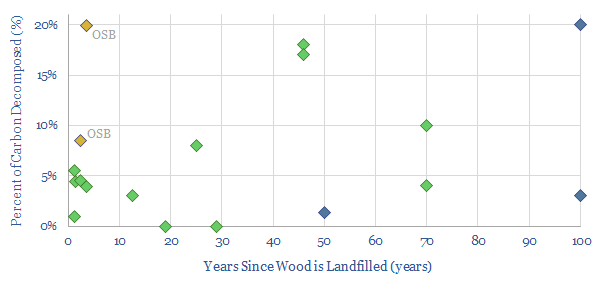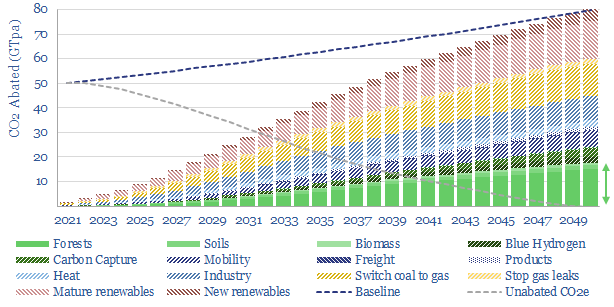Nature based solutions are likely to deliver c20-25% of the decarbonization in a realistic roadmap to net zero. Reforestation is low-cost (c$50/ton), technically ready, practical and helps nature. Key challenges are improving the quality of nature-based CO2 removals and accelerating momentum. We see opportunities for companies that tackle these challenges. Our top conclusions into nature-based solutions to climate change follow below.
(1) Deforestation and land use changes have emitted over 1 trillion tons of CO2 since pre-industrial times, as 5bn acres have been deforested (data here). That is 25% of total net anthropogenic emissions. Today, deforestation continues at a pace of 12M hectares per year (30M acres per year), emitting 6GTpa of CO2e, 12% of the global total, equivalent to all the world’s passenger cars (data here). There is clearly no route to net zero without some renewed balance with nature in the 21st century (note here). And more optimistically, photosynthesis fixes 700GTpa of CO2, compared to anthropogenic CO2 emissions of 50GTpa, so small changes in the natural carbon cycle can have large impacts.
(2) What are CO2 removals? Land that has been deforested will store minimal CO2. Mature forests store an additional 200 tons of CO2-equivalents per acre. Sometimes over 400 tons of CO2-equivalents per acre. Hence over a 40+ year growing cycle, trees take up an average of 5 tons of CO2 per acre per year (data here). The growth rates are sigmoidal (note here). Then ultimately mature forests sequester minimal amounts of CO2 as mature trees grow 40-50% more slowly and biomass decomposition matches new accumulation. CO2 is removed when land moves from ‘not forest’ to ‘forest’ and then stays forested.

(3) Residuals and convenience. Many industrial processes are complex and competitive. Look at the charts for how the world makes carbon fiber (e.g, for wind turbine blades) or polyester (for textiles and solar backsheets), or AI chips, or any of the other metals and materials that explain 40% of all global CO2 emissions; and are needed to build other decarbonization technologies themselves, such as wind, solar and electric vehicles. In our view, there will always be some residual emissions in industrial processes. It will be an order of magnitude more practical to offset these emissions in the forest rather than in the factory. Many industrial companies will be delighted to pay for this service, rather than having to ‘reinvent and retool’ (examples here).
(4) Costs of CO2 removals. Ultimately, companies that offer the best decarbonization product at the lowest price will “win”. Our best model for the costs of reforestation is here, and sees an average CO2 removal cost of $50/ton. We also reach similar numbers when modeling mangrove restoration. $50/ton is feasible. And a long way below high cost technologies, such as DAC credits at $200-1,000/ton (how much do you have to hate nature, to pay $1,000/ton for a DAC credit rather than $50/ton for natural remediation?!). But CO2 removal costs in forests are also variable and can range from $3-120/ton. Economics hinge upon land costs, seedling costs, planting density, yield class, timber product prices. Over time, experience curves will apply in forestry, and many variables can be optimized.
(5) How much land for reforestation? Out of the world’s 40bn acres of land, we think 3bn acres can be reforested (note here, data here). To be realistic, this estimate does not include core croplands, inhospitable climates (e.g., Antarctica), or deserts (although at the upper end of the cost curve, we have explored using waste water in semi-arid petroleum basins, note here). The best land to reforest is drawn from the world’s 5bn acres of degraded-abandoned land and 8bn acres of pasture land. 47 emerging world countries could uplift GDP by 6-60% as they reforest 1.5bn acres via adopting ‘reforest and reinvest’ as an economic development model (note here). For another case study that is superb, nay sublime, look at Finland, which has offset two-thirds of its fossil emissions over the past century (note here). Reforestation potential by country is screened here.
(6) Quality and trust. Historically, carbon offset projects have not had sufficiently high quality, in our opinion. If buyers of carbon credits cannot trust a project, then its future carbon credits will end up heavily discounted. Possibly even valueless. For the highest quality projects, which will attract the highest CO2 prices, there must be no doubt that the project is real, incremental (CO2 removals not avoidance credits), its CO2 must be correctly measured, it should enhance biodiversity (which can even boost CO2 uptake by 15-70%) and the permanence of the CO2 storage should be enhanced by guarantees and buffers.
(7) Where is today’s market? In 2022, Thunder Said Energy contributed $7,700 to nature-based solutions projects, to offset its own CO2 emissions 20x over, studying half-a-dozen projects in detail, using a five-point framework. Today’s market is evolving painfully slowly. It lacks depth and policy support. High-quality credits are most bottlenecked. This makes us wonder whether early adopters will achieve higher returns. Our best note summarizing these findings is linked here.
(8) Controversies? The biggest controversy in today’s carbon markets are over permanence, and our best research note is here, comparing the total CO2 balances of forest products depending on their sources and uses. 1GTpa of timber is still burned for fuel, including biomass and BECCS, which is obviously not permanent. Pulp and paper also has low permanence. Construction materials have high permanence. The oldest wooden structure still standing is Japan’s Horyuji Buddhist temple, constructed in 639AD. There is buried biomass that has lasted 45,000 years (note here). And studies show that 80-95% biomass carbon can remain preserved after 40-100 years in landfill (chart below, data here). There are also environmental controversies, due to forest-climate feedbacks. There are increasing risks of forest fires in fire-prone regions, which need to be managed and ‘buffered’ when booking carbon credits. But forests may also grow 25% faster due to high atmospheric CO2. And enhanced cloud seeding should offset forests’ low albedo.

(9) Other nature-based solutions. Further running room in nature-based CO2 removals includes farming carbon into soils via conservation agriculture (note here), carbon offsets in the ocean (note here), blue carbon (here), savanna management (note here), biochar (note here) and most controversially, ocean iron fertilization (“give me half a tanker of iron and I will give you another ice age”) (note here). Our roadmap to net zero derisks 15GTpa of CO2 removals from forests, 2GTpa from agriculture, and 600MTpa from biochar.
(10) Nature-based CO2 companies. Companies and charities offering CO2 offsets are screened here. Companies measuring forest and soil carbon are screened here. Arborgen is a listed seedling producer. Stora Enso makes sustainable materials from timber products. Cross laminated timber can be used for large construction projects, lowering CO2 by 15-80% compared to steel and cement. Tricoya is a listed mid-cap making a long-lasting engineered timber product. Tigercat is a leader in forestry machinery. More exotically, we have screened biotech and agtech companies increasing the CO2 uptake rates of plant species. Biochar companies are here and aquaculture companies are here. We also think large beneficiaries from nature-based CO2 will include industrial incumbents. Energy incumbents may commercialize zero carbon fuels by offering high-quality CO2 removal credits in conjunction with carbon emitting fuels (note here); and investment firms may offer carbon-neutral funds that dedicate a share of dividend proceeds to abating the look-through CO2 of the funds’ holdings (note here).

